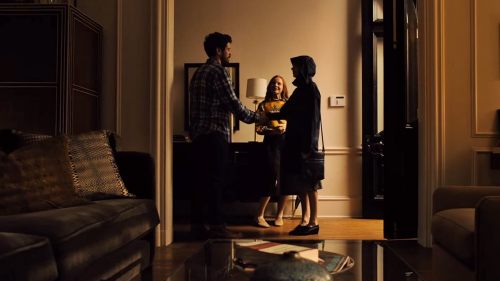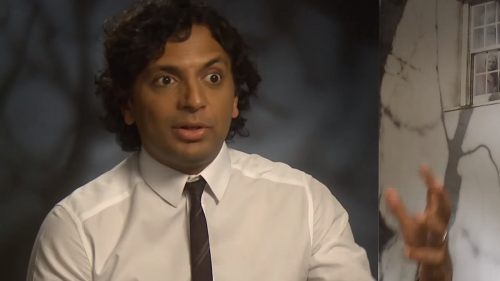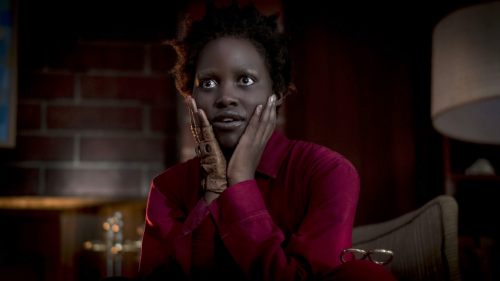UNBREAKABLE: The Film That Launched Our Modern Superhero Renaissance
Glass is in theaters now. Get your tickets here!
Unbreakable, the 2000 film that opened the M. Night Shyamalan trilogy that’s about to be capped off by Glass, features a rare element in most comic book movies: actual comic books. The film beings with a wall of facts about the ubiquity of comic books in society. Samuel L. Jackson’s Elijah Price lives as though his entire life is a superhero narrative about good and evil. Even though Bruce Willis plays David Dunn as a sensitive, self-conscious man trying to shuffle through the day without being noticed, when Elijah explains the extent of his abilities, he understands the archetypical role he’s meant to play, because he understands comic books.
Humanity’s relationship to myth and our ideas about where we fit within those stories is the heart of Unbreakable, perhaps one of the finest examples of the genre in film history. Shyamalan’s movie is the stylistic inspiration for the superhero boom and marked a paradigm shift from the heightened reality of the first wave of comic book films into a grounded world that resembled our own. While it wouldn’t be until 2017’s Logan that a superhero film would be quite so self-referential again, the DNA of Unbreakable can be seen throughout the continuum of the genre.
The existence of superheroes in literature within the universe of a superhero movie is an odd notion. Why would the downtrodden denizens of Tim Burton’s baroque hellscape Gotham City read about costumed vigilantes fighting monsters when they have to suffer through chemical warfare and terrorism almost every day? We have police officers and doctors in our real world, but that doesn’t stop writers from concocting fiction out of those professions. In Alan Moore’s seminal graphic novel Watchmen, superhero stories have been replaced by somber, meditative pirate tales in the popular imagination, cementing the idea that when superheroes exist long enough, people stopped being interested in reading about them.
Beyond its usage as a critical plot point, the existence of superhero comics in Unbreakable signals to the audience that this story takes place in our universe, the one where comic book characters are hugely popular. It didn’t allow for the ironic detachment of previous comic book movies like the Burton Batman films. In particular, Batman Returns veered into black comedy and satire so often that the third act doesn’t have much in the way of emotional stakes. The most poignant scene in that film is the death of the Penguin, as he’s dragged into the sewer water by his family of actual penguins, but even that is played for laughs. The Schumacher Batmans are even more egregious, turning the Batman stories into empty pop spectacles full of cliche dialogue, dated music, and garish production design.
Batman and Robin is widely credited with killing the comic book genre for the rest of the 1990s, but that would be giving the work too much credit. Batman and Robin was the culmination of an entire philosophy on how to make these movies rather than an isolated incident. Lesser known films like The Shadow, Judge Dredd, The Phantom, Barb Wire, Tank Girl, and others that followed Batman during the genre’s initial explosion shared a few base elements: a heavy emphasis on costume and set design; otherworldly, period, or futuristic settings; and a need to undercut the tension with comedy. Granted, in the case of Tank Girl and Judge Dredd, comedy was part of the source material’s legacy, but for the rest, it got in the way of any hope the movies had of connecting to your emotions. All of those films were franchises-to-be that became box office bombs remembered only by genre completists and fans of the characters.
In 1998, just one year after Batman and Robin looked to be the death knell for superheroes in cinema, Blade was released to positive reviews and strong ticket sales. It felt dark and modern, but never lost a sense of fun. In the popular narrative of the rise of superheroes in film, Blade begat X-Men which begat Batman Begins which begat Iron Man. It’s fair to make the argument that Blade was the spark that lit the match. One could even argue that every comic book film at the beginning of the boom is a reaction to the last one, that each one has to exist for us to get to The Avengers. In both of these theories, Unbreakable is like David Dunn after his fateful car accident, left on the side of the road to fend for itself.
While Blade is a pillar of superhero fiction, it shares traits with those first-wave movies. Director Stephen Norrington is a visual stylist who created a fantastical world filled with vampires and blood-soaked raves. It’s elevated exploitation cinema, always bumping up against the grindhouse and the direct-to-video bin (it stars Wesley Snipes, folks), neither of which are intended as insults. Blade is an absolute joy to watch, but its familial connection to later superhero films is less clear thanks to how much it owes to the more traditional action and horror genres.
Aesthetically, X-Men is miles away from Blade or any other superhero movie to that point. To be blunt, it looks bad. This could be due to the truncated budget or the limitations of Bryan Singer as a director, which are more apparent now that critics have a larger data set to analyze. There’s something flat and mundane about X-Men, even as Hugh Jackman, Patrick Stewart, and Ian McKellen leap from the screen with their trio of unforgettable performances. Where Blade has the energy and passion of the grindhouse, X-Men has the glacial pace and heavy dialogue scenes of a TV soap opera. But that was novel in the summer of 2000, when the movie arrived in theaters. A limp third act climax and even-rough-back-then special effects could be overlooked because of how refreshing it was that X-Men was about people first. It couldn’t wow audiences with spectacle, so it was forced to lean on the roots of the source material and take it seriously.
Unbreakable would come out mere months after X-Men, November 22, 2000, to be exact. Because of the nature of when it was released—comic book movies were still an oddity and The Sixth Sense was fresh in the zeitgeist at the time—Unbreakable was marketed more as an M. Night Shyamalan film than a superhero adventure story. It isn’t really much of an adventure, anyway. The film starts with David Dunn on a train trip back from a job interview in New York City. His marriage is on the rocks, so when an attractive younger woman sit down next to him, he clumsily removes his wedding ring. It’s a pretty low place to meet your hero, but it’s also a very human, relatable experience. Superheroes don’t get divorced or cheat on their spouses often, but regular people do. As a protagonist, David Dunn remains fascinating even after multiple rewatches. He speaks in dull whispers and hides in plain sight, to the point where if the viewer didn’t see his innate goodness later on, they might also choose to get up and change seats like the young woman on the train. Willis’s performance is vastly underrated for how much he can convey with such a still, introverted character. In a way, it has a lot in common with Michael Keaton’s work as Bruce Wayne in the Burton Batman movies. Both Dunn and Keaton’s Wayne are terribly uncomfortable, bordering on socially awkward, but come alive when they discover their purpose.
The idea of purpose—what our mission is and why we are even alive in the first place—is the ultimate question of Unbreakable. To quote Star Trek: The Motion Picture, “Is this all that I am? Is there nothing more?” Elijah and David are both searching for that answer and ultimately find their purpose in each other. It’s a classic superhero trope, one that is referenced, but glossed over in first-wave comic book films like Batman and Superman: The Movie in favor of spectacle and Ned Beatty cracking jokes, but is given full expression here. This same question comes back yet again in the pivotal year of 2008, where both Iron Man and The Dark Knight ask it in different ways. Tony Stark is a hedonist who learns his purpose through the humility of a near-death experience. In The Dark Knight, Batman reconsidered his own purpose when he realizes he’s inspired the nihilist known as The Joker.
If any comic book franchise owes a clear, direct debt to Unbreakable, it’s those Nolan Batman films. Unbreakable found ways to place the superhero myth into a real-world context. It would be silly for David Dunn to wear a cape and a mask, but wearing a long, green rain slicker makes sense. One, it’s raining during Dunn’s climactic confrontation with the Orange Man. Two, Dunn has recently learned his only weakness is exposure to water. That the rain slicker hangs like a cape when the two children he’d just saved rescue him from the pool is a happy coincidence that makes for one of the most stirring, indelible images in the entire film. That he continues to wear the rain slicker in Glass, in scenes where it’s not raining shows that he’s adopted it as a costume and embraced his place as a real-life superhero.
Batman Begins takes this idea of the practicality of the costume to another level. Nolan borrows an idea from the source material, which is that Bruce Wayne dresses like a bat to terrify his enemies, to be a symbol to inspire Gotham City. Instead of just showing up in a costume one day, we see how he assembles it and why. The sequence of Alfred explaining how he’ll covertly purchase the parts for his armored Batman suit and Bruce forging Batman-shaped ninja stars is almost totally unnecessary to the story, but it is needed to answer logical questions the audience might have. It says, “we take this seriously. This is real.” Unlike David Dunn, Bruce Wayne is a mythic figure from the beginning, never doing anything as common as trying to cheat on his wife. Still, we see Wayne at his lowest point, revealing to Rachel Dawes he intended to murder Joe Chill after his sentencing hearing. As David Dunn has to find the hero inside of him, so must Bruce Wayne grow into Batman.
Batman Begins also strips down much of the set and costume design quirks of comic book movies, as Unbreakable (and X-Men) did five years prior. It’s a world recognizable as our own, with some flourishes like the Narrows and the futuristic elevated train that would be long gone by the time The Dark Knight came out in 2008. It also had to have a more elaborate climax than Batman choking out a sociopathic, home-invading janitor. But even the Narrows has a real-world analog in Hong Kong’s Kowloon Walled City, which was demolished in 1993. X-Men declared its intentions with the audacious opening scene in Auschwitz, an unheard of level of grounding in a comic book film, but Unbreakable made its reality an explicit part of the narrative. It was a superhero movie about superheroes, a psychological investigation of why these stories matter almost a decade before they took over every aspect of our lives.
Though Glass is the official sequel to Unbreakable, its spiritual successor is James Mangold’s Logan, the final X-Men film to feature Hugh Jackman as Wolverine. It’s fitting that Logan picks up so much thematic ground from Unbreakable, since the original X-Men and Unbreakable are so closely tied to each other in the history of comic book movies. Logan is a shell when we meet him again, driving a limousine so he can pay for Professor Xavier’s medication and eventually fund an escape out of the misery of modern life in the near-future. He’s drinking too much and his powers are weakening. David Dunn is a sad-sack who discovers his abilities, despite his inclination to hide. In that first X-Men, Logan is also hiding his power, and in this last film, he’s gone back into that state out of fear. There might be mutants, cyborgs, and self-driving freight trucks, but Logan shares with Unbreakable a raw, wounded heart that keeps it from ever feeling anything like a superhero film. Most importantly, it’s a story about stories. X-23 uses actual X-Men comics to inspire Logan to fight back as they’re on the run, to be the Wolverine one last time. Introducing X-Men comics into the film universe is a bold choice that could have felt navel-gazing and corny, but instead it taps into Unbreakable’s interest in how and why we create these myths in the first place. It’s their power to inspire good within us, to teach us morals, and to grasp at something resembling purpose in this confusing existence.
Even amongst the hype train surrounding Glass, Unbreakable still feels underrated and underappreciated. It’s not a movie based on an existing intellectual property and M. Night Shyamalan fell out of favor with the moviegoing populace years ago. Marvel has since injected broad comedy back into the superhero movie, though remarkably without sacrificing emotional resonance. The ending, with its cheesy epilogue cards filling in off-screen plot details, leaves a hollow feeling after a deeply moving experience. Still, its influence cannot go unrecognized. It was the first superhero movie to truly look inward, to fully humanize its characters, and to see the ultimate potential of a genre that continues to look back to it for inspiration. That a proper sequel finally exists almost 20 years later is a testament to the enduring power of Unbreakable’s ideas and how deeply they have penetrated our world.



